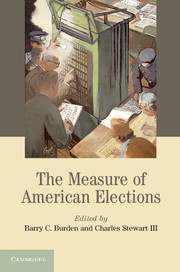Book contents
- Frontmatter
- Contents
- List of figures
- List of tables
- List of contributors
- Acknowledgments
- 1 Introduction to the Measure of American Elections
- 2 Registration and Voting: A View from the Top
- 3 Voter Registration: The Process and Quality of Lists
- 4 Provisional Ballots
- 5 Mail Ballots in the United States: Policy Choice and Administrative Challenges
- 6 Voting from Abroad: Evaluating UOCAVA Voting
- 7 Polling Place Practices and the Voting Experience
- 8 Disability and Election Policies and Practices
- 9 The Performance of Election Machines and the Decline of Residual Votes in the United States
- 10 Voter Confidence as a Metric of Election Performance
- 11 Election Data Transparency
- Appendix
- References
- Index
3 - Voter Registration: The Process and Quality of Lists
Published online by Cambridge University Press: 05 August 2014
- Frontmatter
- Contents
- List of figures
- List of tables
- List of contributors
- Acknowledgments
- 1 Introduction to the Measure of American Elections
- 2 Registration and Voting: A View from the Top
- 3 Voter Registration: The Process and Quality of Lists
- 4 Provisional Ballots
- 5 Mail Ballots in the United States: Policy Choice and Administrative Challenges
- 6 Voting from Abroad: Evaluating UOCAVA Voting
- 7 Polling Place Practices and the Voting Experience
- 8 Disability and Election Policies and Practices
- 9 The Performance of Election Machines and the Decline of Residual Votes in the United States
- 10 Voter Confidence as a Metric of Election Performance
- 11 Election Data Transparency
- Appendix
- References
- Index
Summary
INTRODUCTION
Voter registration is the backbone of election administration in the United States. Registration lists are used to establish eligibility to vote, to determine the offices for which one can vote, to communicate to citizens when elections occur and where and how to vote, to validate people at the polls, and to audit elections after the fact. In many ways U.S. voter registration is a remarkable system. A highly decentralized set of authorities consisting of more than 5,000 municipal and county election officials collaborate on state and local voter databases.
Election administrators and the public as a whole place a premium on accuracy of the lists. Poorly maintained lists can make it difficult for administrators to communicate with voters or to run the election at the polls. Errors in the lists used by the local election offices can prevent some legitimate voters from participating and may be abused by those seeking to perpetrate voter fraud. Election administrators devote considerable effort to continual management of the voter lists. This is a difficult task, especially in less well-staffed offices, and errors do occur. Any effort to improve the quality of lists can be greatly informed by data about the accuracy of the voter files. How common are different sorts of problems, do errors follow systematic (and possibly correctable) patterns, and what are the consequences of different sorts of errors?
- Type
- Chapter
- Information
- The Measure of American Elections , pp. 61 - 90Publisher: Cambridge University PressPrint publication year: 2014
- 15
- Cited by



